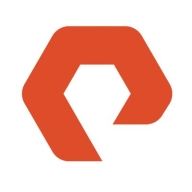


IBM Cloud Object Storage and MinIO are key players in the cloud storage sector, aiming to offer excellent scalability and security. While IBM Cloud Object Storage provides strong support and economical pricing, MinIO stands out with advanced features and superior performance.
Features: IBM Cloud Object Storage delivers enhanced data protection, scalability, and integration capabilities, suitable for large enterprises needing comprehensive solutions. MinIO offers high-performance capabilities, robust API support, and simplicity, benefiting high-demand use cases. IBM stands out for its significant security features, while MinIO's lightweight architecture is admired for efficiency.
Room for Improvement: IBM Cloud Object Storage could improve in offering more flexible API options and optimizing performance for smaller deployments. Additionally, enhancing data retrieval speeds could be beneficial. MinIO can focus on expanding its structured support services, enhancing integration with legacy systems, and improving deployment scalability in large enterprise environments.
Ease of Deployment and Customer Service: IBM Cloud Object Storage offers a streamlined deployment process with extensive customer support, facilitating integration into existing IT setups. MinIO offers straightforward deployment with significant community support and comprehensive documentation, appealing to those seeking an easy setup.
Pricing and ROI: IBM Cloud Object Storage involves a higher initial cost but provides competitive long-term ROI through its enterprise-grade solutions and extensive support. MinIO offers a cost-effective solution with minimal initial investment, attracting businesses prioritizing agility and cost efficiency.
| Product | Market Share (%) |
|---|---|
| MinIO | 17.4% |
| Pure Storage FlashBlade | 5.6% |
| IBM Cloud Object Storage | 1.0% |
| Other | 76.0% |



| Company Size | Count |
|---|---|
| Small Business | 11 |
| Midsize Enterprise | 11 |
| Large Enterprise | 21 |
| Company Size | Count |
|---|---|
| Small Business | 3 |
| Midsize Enterprise | 2 |
| Large Enterprise | 4 |
| Company Size | Count |
|---|---|
| Small Business | 11 |
| Midsize Enterprise | 4 |
| Large Enterprise | 9 |
FlashBlade is the industry’s most advanced scale-out storage for unstructured data, powered by a modern, massively parallel architecture to consolidate complex data silos (like backup appliances and data lakes) and accelerate tomorrow’s discoveries and insights.
IBM Cloud Object Storage is a web-scale platform that stores unstructured data - from petabyte to exabyte - with reliability, security, availability and disaster recovery without replication.
MinIO is an open-source object storage system. It is designed to efficiently store and retrieve unstructured data, such as photos, videos, and backups. MinIO can be used as a standalone object storage server or as part of a larger system, such as a data lake or a private cloud, and can be deployed on-premise, in the cloud, or in a hybrid environment, making it a flexible storage solution for a variety of use cases.
MinIO’s features include erasure coding, bitrot protection, and checksum validation, which help ensure data integrity and reliability. The solution’s multi-tenancy support makes it ideal for multi-user environments. MinIO’s edge computing tools enable data storage and processing closer to users' locations, reducing latency and improving performance. MinIO can easily scale to accommodate storage and power demands, making it ideal for use in large-scale, data-intensive environments.
MinIO Benefits and Features:
MinIO offers several key benefits and features for organizations looking for a scalable and high-performing object storage solution:
Reviews from Real Users
MinIO stands out among its competitors for a number of reasons. Several major ones are its flexibility, integration options, and performance.
Süleyman Fazıl Y., a senior software engineer at a tech services company, writes, “The most valuable features are that MinIO is open, it works on-premise, and is compatible with the Amazon industry which is great for finding compatible libraries in many languages which is very good for developers.”
Rebecca S., CTO at NIASE, says, “MinIO is much improved over the prior solution, updates are simple to apply, and we anticipate that future capacity requirements will be easier to meet. Our customers are using this solution to retrieve tens of thousands of objects (documents and files) per hour, and MinIO seems to be able to keep up with it.”
We monitor all File and Object Storage reviews to prevent fraudulent reviews and keep review quality high. We do not post reviews by company employees or direct competitors. We validate each review for authenticity via cross-reference with LinkedIn, and personal follow-up with the reviewer when necessary.